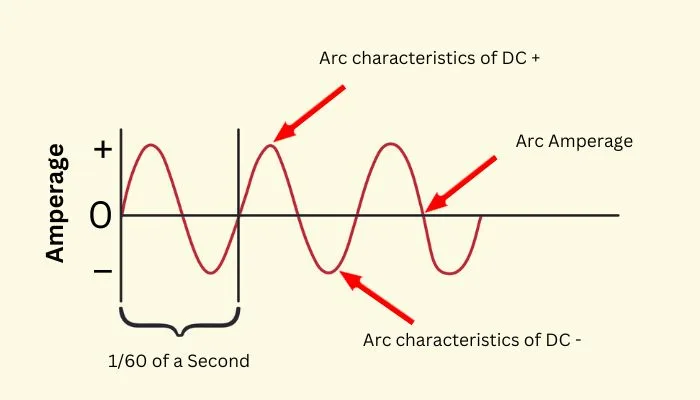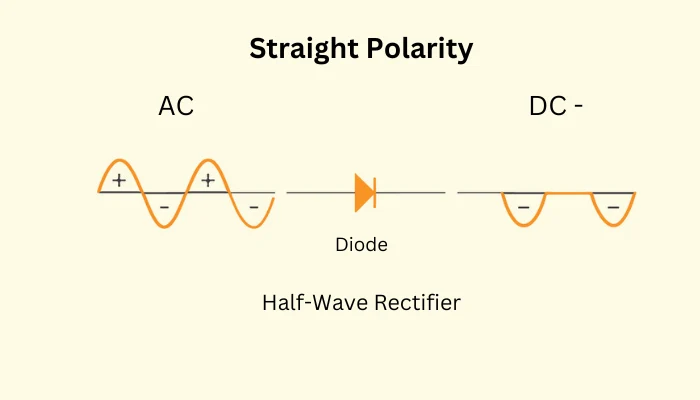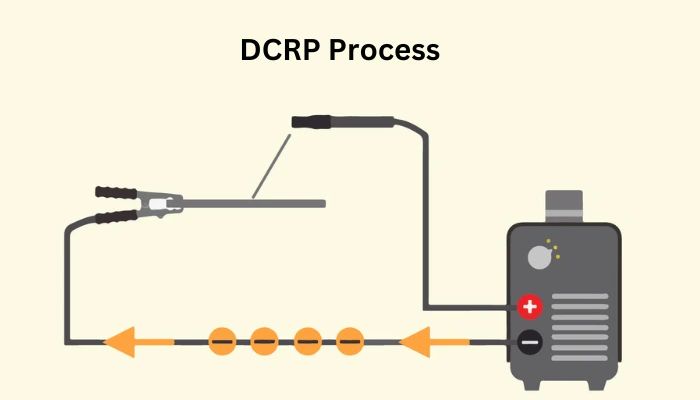Polarity in Welding: How Polarity Perfects Your Welds!
Updated: 11 Dec 2023
118
In the world of Welding, where we join metals to build substantial structures, there is an essential factor called “polarity” that makes the difference between a good weld and a weak one.
Think of it as an entrepreneur leading a group of people in a specific business – the same case with Polarity, which guides the flow of electricity, controlling the heat and melting metal.
As we know, Polarity has an essential role in Welding, so first, we will understand what Polarity is. Second, we will acknowledge the role of polarity in Arc welding process and go deeper into it. So, if you are ready, then let’s start.
What is Polarity?
Polarity is the property of having poles or being polar. These poles have either positive or negative charges. It tells us the direction of the electric current. Beyond that, Polarity can also mean having two opposite or conflicting sides, like having two different opinions or tendencies that don’t quite agree. So, in simple terms, Polarity is about things having two opposite aspects or directions.

© weldingvilla.com – Image usage rights
Understanding Polarity in Welding:
When it comes to understanding Polarity in Welding, it is defined as; “the forming of opposite charges or poles on plates through a welding machine in an electrical circuit and flow of current occur for welding purposes.”
Polarity has a significant impact on Welding. As Polarity controls your welding process effectively, it is essential to know every aspect of Welding.
Why Polarity is important in Welding?
Polarity is essential in Welding because it influences the distribution of heat and the interaction between the electrode and the workpiece. By controlling the direction of the electrical current, welders can optimize the welding process, ensuring better penetration, reduced spatter, and improved overall quality of the weld.
Relationship of Polarity with DC and AC Welding:
Welding Polarity is closely linked to the type of current used in the Welding process. There are two main categories: direct current (DC) and alternating current (AC). Let’s explore the types of Polarity within these categories.
Types of Polarity (Based on Charges or Current in Circuit)
According to Welding, Polarity can be divided into three parts: direct current straight Polarity, direct current reverse Polarity and alternating current Polarity.
1. DC Straight Polarity: (DCSP)

https://weldguru.com/polarity-in-welding/
This type of Polarity helps in Welding in such a way that the electrode is negatively charged, and the plates are positively charged, in which current flows from the plates toward the electrode. In this circuit, the electrons (negative charges) move from the positive pole to the negative pole.
You may wonder why we created such a circuit because the electrons are highly reactive and produce more energy as compared to the protons (positive charges). Simply, suppose we divide heat into three parts. In that case, 3 percent heat will be generated on electrodes, and 1 percent heat will be produced on plates, which turns the electrode metal into molten metal and gets deposited on welding plates.

© weldingvilla.com – Image usage rights
So here is a question: why don’t the plates melt? Because the plates are connected with the positive poles of the machine where the heat is very, very low, like one-third of the electrode. So, when an electrode and plates come in contact, they form a circuit in which the electrode melts and deposits on the plates.
| Benefits: |
|---|
|
| Drawbacks: |
|---|
|
Below, you can check the visual representation of the straight polarity in welding process.
2. DC Reverse Polarity: (DCRP)

https://weldguru.com/polarity-in-welding/
DCRP facilitates Welding by positively charging the electrode and negatively charging the plates, resulting in a current flow from the electrode toward the plates. In this circuit, the electrons, representing negative charges, move from the positive pole to the negative pole.
We do this because the electrons are highly reactive and produce more energy as compared to the protons (positive charges). In simple terms, when dividing the heat into three parts, 3 percent of the heat is generated on the plates, and 1 percent of the heat is produced on the electrode. This process transforms small pieces of metal into large pieces, such as copper metal.

© weldingvilla.com – Image usage rights
The electrode remains uniform because it is connected to the positive poles of the machine, where the heat is significantly lower and on the other hand, it is the opposite for base plates. So, when the electrode makes contact with the plates, a circuit is formed, causing the plates to melt.
| Benefits: |
|---|
|
| Drawbacks: |
|---|
|
3. Alternating Current (AC) Polarity: (ACP)
In AC polarity welding, the direction of the current constantly changes, resulting in a balanced distribution of heat. This helps prevent overheating of the electrode and workpiece (Base Plates). However, AC welding can be less efficient compared to DC welding in certain applications.
The Procedure of ACP:
The process of alternating current Polarization occurs in a way that straight and reverse Polarity come one after another simultaneously. This forms a cycle in which one half will be straight Polarity (Plates = Positive, Electrode = Negative), and the other half will be reverse Polarity (Plates = Negative, Electrode = Positive).
The frequency of AC polarity repeats the cycle regularly 50 to 60 times per second, but you can change the frequency by providing high power sources.
| Benefits: |
|---|
|
| Drawbacks |
|---|
|
Polarity in GMAW Welding Hyperbaric Environment With Chart:
In a hyperbaric environment, the Gas Metal Arc Welding (GMAW) process, utilizing Direct Current Electrode Positive (DCEP) and Direct Current Electrode Negative (DCEN), exhibits varying sizes of weld bead geometries. These sizes represent the width and height of the welded joints, providing insight into the welding performance in high-pressure conditions.
| Pressure p/MPa | Reinforcement a/mm | Weld width B/mm | Penetration H/mm |
|---|---|---|---|
| DCEP, DCEN | DCEP, DCEN | DCEP, DCEN | |
| O.1 | 1.9, 3.7 | 10.6, 15.3 | 4.6, 2.3 |
| 0.4 | 2.8, 3.5 | 9.4, 13.2 | 6.1, 4.1 |
| 0.7 | 3.2, 4.3 | 7.2, 10.2 | 6.2, 5.9 |
| 1.0 | 3.2, 4.5 | 6.5, 8.1 | 6.5, 6.2 |
Which Polarity is best for Welding?
The choice of Polarity in Welding depends on various factors, including:
- Welding process
- Materials being joined
- Specific project requirements
There is no single answer for everyone because different polarities work better in different situations, each having its advantages. For example, DC Straight Polarity (DCSP) is often preferred for thin materials, while DC Reverse Polarity (DCRP) is suitable for thicker materials. Alternating Current (AC) polarity is chosen for its balanced heat distribution. Ultimately, the best Polarity for Welding varies based on the specific needs of the welding application.
Exploring the Effect of Polarity on Welding Performance:
1. Penetration
- Deep penetration: Polarity plays a crucial role in determining the depth of penetration during Welding. DC Straight Polarity (DCSP) is known for providing deep penetration and is suitable for welding thick materials.
- Shallow Penetration: DC Reverse Polarity (DCRP) is known for providing shallow penetration and is suitable for welding thin materials.
2. Heat-Affected Zone (HAZ):
The choice of Polarity influences the size and characteristics of the heat-affected zone (HAZ). By selecting the appropriate Polarity, welders can control the extent of thermal changes on the material surrounding the weld.
3. Base Plate Cleaning:
Different polarities affect the cleaning action on the base plate. Understanding this change helps welders optimize the removal of impurities and contaminants, which make a strong bond between the welded components.
4. Weld Bead Appearance:
Polarity contributes significantly to the aesthetics of the weld bead. It changes the shape, width, and overall appearance of the bead, affecting not only the visual aspect but also the structural integrity of the weld.
5. Reinforcement Levels:
The selected Polarity can control the amount of reinforcement in a weld. Welders can adjust the reinforcement levels based on project requirements and the type of materials being joined.
6. Maintaining Heat Balance:
Achieving the right heat balance is essential in Welding, and Polarity plays a pivotal role in maintaining this balance. Proper heat control ensures a successful weld with minimal distortion and consistent quality.
7. Electrode Capacity:
Different polarities impact the capacity of the welding electrode. For instance, DC Reverse Polarity (DCRP) is known for improved weld deposition, making it suitable for welding thicker materials where higher electrode capacity is required.
8. Deposition of Weld:
The selected Polarity influences the deposition of weld metal. Welders choose the most appropriate setup for achieving the desired weld size and strength.
Frequently Asked Questions:
What happens if you weld with the wrong Polarity?
Welding with the wrong Polarity can lead to various issues in the welding process. For instance, using an incorrect polarity may result in;
- Poor Penetration
- Insufficient Fusion
- Compromised Weld Bead Appearance
How do you check the Polarity of a Welder?
To check the Polarity of a welder, you can perform two simple tests.
Test No 1: Place the compass near the welding electrode; if the needle moves, the electrode is the positive pole. Alternatively, if the needle moves near the workpiece, the workpiece is the positive pole.
Test No 2: Another test involves using a voltage meter to measure the voltage between the electrode and the workpiece. A positive reading indicates DC Reverse Polarity (electrode positive), while a negative reading indicates DC Straight Polarity (workpiece positive). Always consult the welder’s manual for specific guidance on polarity checking.
What happens if the Polarity is reversed?
If Polarity is reversed in Welding, it can lead to bad effects on the welding process. For instance, in DC welding, reversing the Polarity may result in insufficient penetration, poor fusion, and an irregular weld bead appearance. It can also impact the cleaning action on the base plate and lead to increased spatter.
Final Thoughts:
Polarity is a critical aspect of Welding that can significantly impact the quality and efficiency of the welding process. Understanding the different types of Polarity and their effects on welding performance is essential for welders to make informed decisions and produce high-quality welds. By choosing the correct Polarity for the welding process, welders can achieve great results.
If you think this article is information for welders like you, then you can share it with your friends through different social media platforms. Please share your thoughts and feelings about this article in the comment section so that people understand what value we have provided.
And, of course, If you have a problem related to our blog post, you can inform us through our Contact Us page. Our team will be always there to help you. Thank you for visiting our website.
Please Write Your Comments